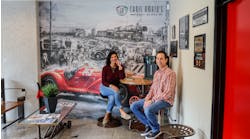Husband and wife team take circuitous path back to family shop
The Middletown, N.Y., shop, in fact, was what brought John and Christine together in the first place. The couple met when John started working there and later married, so it was natural that they'd both return when her father decided to step down. "We were so familiar with the shop, [the transition] was pretty seamless," John says. "What we learned outside the shop was what was really worthwhile because we got to bring our different careers back to the business."
The two biggest changes they made were establishing DRPs with insurance companies and introducing new marketing tactics. "We're now much more insurance oriented," John says. "We know what the insurance companies expect and have a good idea what the customers expect."
In their first four years back at the shop they brought it ahead about 10 years, John says, in terms of insurance cycle time and quality. "When we came back the shop was stuck in the mid-'90s," he says. "When we came back we brought it up to speed and adopted more DRP programs. We brought it up to speed to bring the newest programs on board and adopted their philosophies about cycle time and service."Today Lothar's Body Shop focuses almost entirely on collision repair, whereas Lothar Schoenfeld also accepted rust repair, paint jobs and other projects. John Trifari also developed a more selective process for establishing insurance partnerships. "We've actually eliminated a few," he says. "We go through and analyze them based on the amount of work they send and the amount of work we have to do per claim. We eliminated ones that were low volume and heavy on administrative time, and we've found that it makes a big difference in profitability."
His philosophy is counter to prevailing wisdom that says the more DRPs the better, but John says he sees no reason not to expect insurance companies to be as competitive as they expect body shops to be. "Some programs require photos and estimates and onward and onward of forms, so that actually takes up our time when we could be doing more repairs on cars," he adds. "It's ironic — as we've eliminated some programs, we've seen ourselves get more profitable." His approach is DRP-savvy rather than DRP-friendly.
Leveraging Christine's sales and marketing background, the Trifaris also employed several new marketing tactics designed to develop and increase brand awareness. "We created a logo and emblazoned it on everything," she says. "We put a new logo on all uniforms and put it in the building. We refurbished our employee break room and have a big logo emblazoned on one of the far walls." They also created a tagline for the business and began tracking how customers discovered the shop — whether in an ad, by word-of-mouth or from driving past it — with customer response cards.
The Trifaris also made subtle physical changes to the 14,000-sq.-ft. shop that's undergone three complete renovations since Lothar's relocated there in 1967. They repainted and redecorated the common areas to make them friendlier and more inviting. Today some insurance companies hold meetings in the body shop's break room.
All these changes — selective DRPs, marketing tactics and cosmetic improvements — have added up to a more streamlined operation with a 45-percent increase in sales. "The biggest hurdle we've faced has been efficiency," John says. "We keep all our old, broken parts outside the shop. Being cleaner and more efficient has made a world of difference. We also have weekly production meetings [where we discuss] every vehicle on the lot on our production schedule. Our managers and foreman get together every week and figure out where we are with each vehicle. It keeps us up to date."
The next move for the shop? Lothar's Body Shop doesn't have a Web presence, so a new Web site is on the agenda — but it's not the first priority, the Trifaris say. The next major change will be to add a second shift from 3:30 p.m. to 11:30 p.m. — the shop currently operates 8 a.m. to 4:30 p.m. "Economically this makes more sense at this point — to use this location as much as possible," he says. "We're currently filling positions right now."
He won't predict the additional volume the second shift would bring, but says "even if we did an extra 25 repairs, it would be a big improvement."

